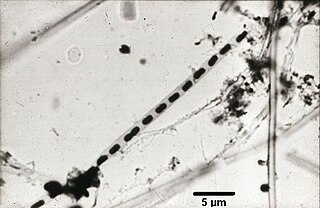Related Research Articles

The Comamonadaceae are a family of the Betaproteobacteria. Like all Pseudomonadota, they are Gram-negative. They are aerobic and most of the species are motile via flagella. The cells are curved rod-shaped.

The Methylobacteriaceae are a family of Hyphomicrobiales.

The Oceanospirillales are an order of Pseudomonadota with ten families.
Perlucidibaca is a genus of Gram-negative, oxidase-positive and catalase-negative, motile bacteria with a polar flagellum, which belong to the class Gammaproteobacteria.
Perlucidibaca piscinae is a gram-negative, oxidase-positive and catalase-negative, facultatively aerobic, motile bacterium with a polar flagellum from the genus of Perlucidibaca which was isolated from an eutrophic pond.
The Lachnospiraceae are a family of obligately anaerobic, variably spore-forming bacteria in the order Eubacteriales that ferment diverse plant polysaccharides to short-chain fatty acids and alcohols (ethanol). These bacteria are among the most abundant taxa in the rumen and the human gut microbiota. Members of this family may protect against colon cancer in humans by producing butyric acid. Lachnospiraceae have been found to contribute to diabetes in genetically susceptible (ob/ob) germ-free mice.
Acidicapsa is a bacterial genus from the family of Acidobacteriaceae.
Marinomonas is an aerobic bacteria genus from the family of Oceanospirillaceae.
Gaiella occulta is a rod-shaped and non-motile bacterium from the genus Gaiella which has been isolated from deep mineral water in Portugal.
Salipaludibacillus is a gram-positive genus of bacteria from the family of Bacillaceae.
Chitinispirillum is a genus of bacteria from the family of Chitinispirillaceae with one known species. Chitinispirillum alkaliphilum has been isolated from hypersaline lake sediments from the Wadi el Natrun valley in Egypt.
Phaeobacter porticola is a bacterium from the genus of Phaeobacter which has been isolated from barnacle from Neuharlingersiel in Germany.) Phaeobacter porticola produces antibiotics.
Pseudophaeobacter arcticus is a psychrophilic, Gram-negative, rod-shaped and motile bacteria from the genus of Pseudophaeobacter which has been isolated from the Arctic.
Phaeobacter inhibens is a bacterium from the genus of Phaeobacter which has been isolated from seawater from Galicia in Spain.
Pseudophaeobacter leonis is a Gram-negative, strictly aerobic and heterotrophic bacteria from the genus Pseudophaeobacter which has been isolated from anoxic marine sediments from the Gulf of Lions.
The Hahellaceae are a family of Pseudomonadota in the order of Oceanospirillales.
Phycisphaeraceae is a family of bacteria.
Singulisphaera is a moderately acidophilic and mesophilic genus of bacteria from the family of Planctomycetaceae.
Sedimentitalea is a genus of bacteria from the family of Rhodobacteraceae.
Niabella is a genus of bacteria from the family of Chitinophagaceae.
References
- 1 2 Parte, A.C. "Phaeobacter". LPSN .
- 1 2 "Phaeobacter piscinae". www.uniprot.org.
- 1 2 Sonnenschein, EC; Phippen, CBW; Nielsen, KF; Mateiu, RV; Melchiorsen, J; Gram, L; Overmann, J; Freese, HM (November 2017). "Phaeobacter piscinae sp. nov., a species of the Roseobacter group and potential aquaculture probiont". International Journal of Systematic and Evolutionary Microbiology. 67 (11): 4559–4564. doi: 10.1099/ijsem.0.002331 . PMID 28984543.
- ↑ Parker, Charles Thomas; Garrity, George M (1 January 2003). Parker, Charles Thomas; Garrity, George M (eds.). "Nomenclature Abstract for Phaeobacter piscinae None 2015". The NamesforLife Abstracts. doi:10.1601/nm.30984.